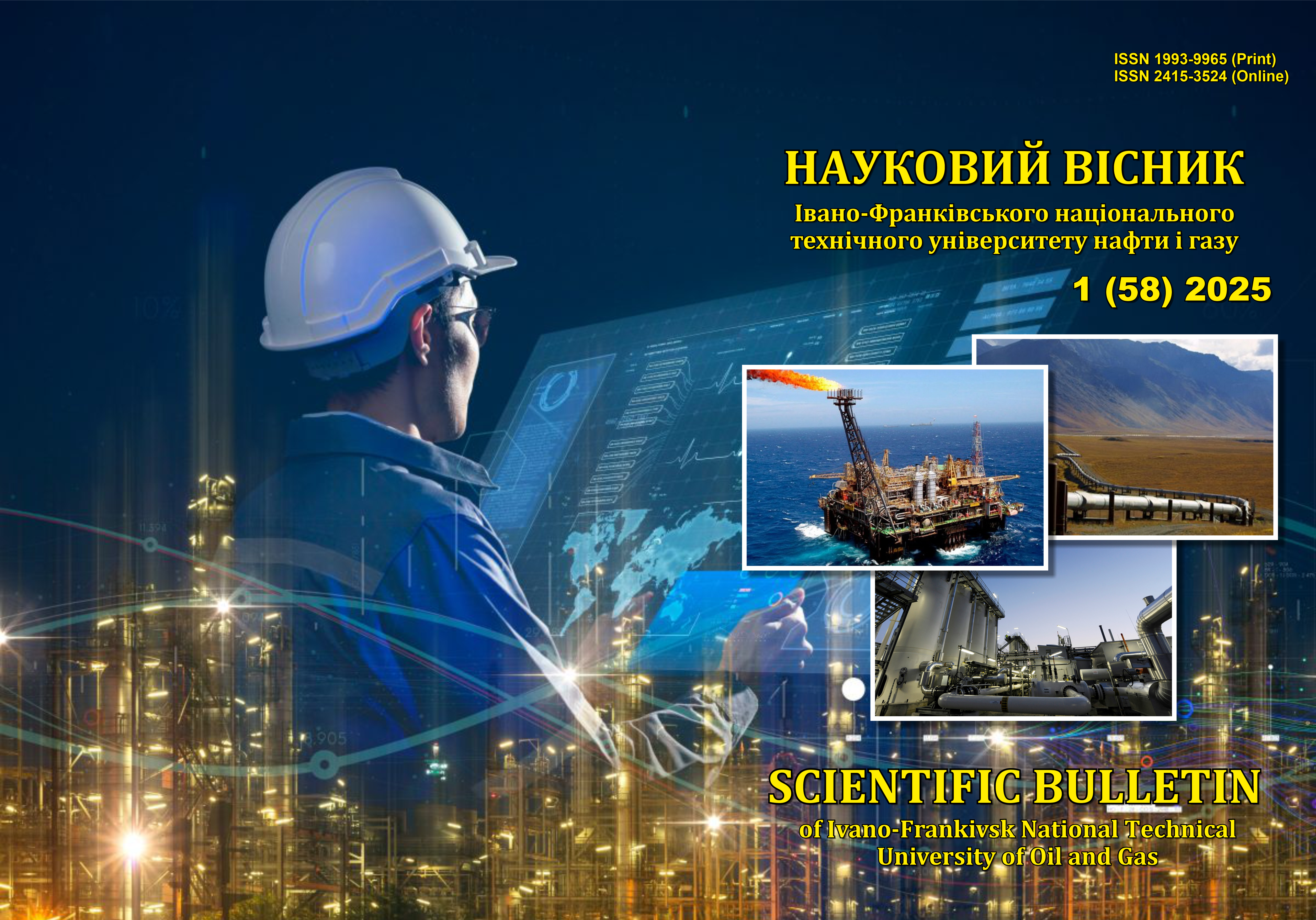ANALYSIS OF THE POSSIBILITIES OF USING COMPRESSED AIR ENERGY SYSTEMS IN POWER DRIVES OF OIL AND GAS TECHNOLOGICAL TRANSPORT
DOI:
https://doi.org/10.31471/1993-9965-2025-1(58)-36-50Keywords:
oil and gas transport, compressed air, pneumatic drive, power drive, energy systemAbstract
This article analyzes the potential of using compressed air power systems in the power drives of process transport within the oil and gas industry. The advantages and limitations of pneumatic systems are considered in comparison with conventional hydraulic and electromechanical drives. Key technical parameters influencing the efficiency of such systems are identified, including energy consumption, energy losses, and operational reliability under high-load conditions. The paper assesses the prospects of integrating modern technologies for compressed air accumulation and regulation to enhance equipment productivity and environmental safety. Possible directions for system optimization are proposed, aimed at reducing operational costs and improving energy efficiency in industrial processes. A compressed air-based energy system with zero emissions can serve either as a primary power source or as an auxiliary power unit in transport applications, offering the benefits of carbon-free operation and increased overall energy efficiency. The article provides a comprehensive technological overview of compressed air power systems, summarizing current research in the transportation sector, including valve technology innovations, prototype development, and system integration. Furthermore, various pneumatic hybrid technologies are explored in detail, offering insights into the potential and constraints of different hybridization approaches. The opportunities and challenges associated with implementing compressed air technologies in the power drives of process transport are discussed. It is expected that the transition to such systems in the oil and gas sector will foster technological advancement and the adoption of zero-emission compressed air solutions.
Downloads
References
Marvania D., Subudhi S. A comprehensive review on compressed air powered engine. Renew. Sustain. Energy Rev. 2017. Vol. 70. P. 1119-1130.
Fang Y., Lu Y., Yu X., Roskilly A.P. Experimental study of a pneumatic engine with heat supply to improve the overall performance. Appl. Therm. Eng. 2018. Vol. 70. P. 78-85.
Y. Fang, Y. Lu, X. Yu, L. Su, Z. Fan, R. Huang, et al. Study of a hybrid pneumatic-combustion engine under steady-state and transient conditions for transport application. Int. J. Engine Res. 2019. P. 1-12.
Y. Shi, F. Li, M. Cai, Q. Yu. Literature review: present state and future trends of air-powered vehicles. J. Renew. Sustain. Energy. 2016. Vol. 8. Article 025704.
F. Wasbari, R.A. Bakar, L.M. Gan, M.M. Tahir, A.A. Yusof. A review of compressed-air hybrid technology in vehicle system. Renew. Sustain. Energy Rev. 2017. Vol. 67. P. 935-953.
S. Thipse. Compressed Air Car. Special Feature: Air Pollution Control Technologies. 2008. URL: http://www.techmonitor.net/tm/images/1/18/08nov_dec_sf4.pdf
J.-Q. Hu, X.-L. Yu, L. Liu, X.-H. Nie. Dynamic characteristics of in-cylinder flow field in air-powered engine Zhejiang Daxue Xuebao (Gongxue Ban) / J. Zhejiang Univ. (Eng. Sci.). 2007. Vol. 41. P. 1912-1915. View in ScopusGoogle Scholar
R. Song, X. Fu, M. Cai. Non-dimensional modeling and simulation analysis of air powered engine/ Appl. Mech. Mater. 2013. Vol. 278–280. P. 307-314.
Q.Y. Xu, Y. Shi, Q.H. Yu, M.L. Cai. Virtual prototype modeling and performance analysis of the air-powered engine. Proc. Int. Mech. Eng. C-J. Mech. 2014. Vol. 228. P. 2642-2651
Q.H. Yu, M.L. Cai, Y. Shi. Working characteristics of two types of compressed air engine. J. Renew. Sustain. Energ. 2016. Vol. 8. Google Scholar
W. He, Y. Wu, Y. Peng, Y. Zhang, C. Ma, G. Ma. Influence of intake pressure on the perfor-mance of single screw expander working with compressed air. Appl. Therm. Eng. 2013. Vol. 51. P. 662-669.
G. Jia, X. Wang, G. Wu. Study on ultrahigh pressure and large flow rate pneumatic on-off valve. Jixie Gongcheng Xuebao / Chin. J. Mech. Eng. 2004. Vol. 40. P. 77-81.
J.-L. Cai, X.-L. Yu, G.-J. Yuan, Y.-M. Shen. Influence of port timing on work process of air-powered engine. Zhejiang Daxue Xuebao (Gongxue Ban) / J. Zhejiang Univ. (Eng. Sci.). 2004. Vol. 38. P. 65-69.
Q.H. Yu, M.L. Cai, Y. Shi, C. Yuan. Dimensionless study on efficiency and speed characteristics of a compressed air engine. J. Energy Resour. ASME. 2015. Vol. 137.
Q.H. Yu, M.L. Cai, Y. Shi, Q.Y. Xu. Optimization study on a single-cylinder compressed air engine. Chin. J. Mech. Eng.-En. 2015. Vol. 28. P. 1285-1292. View in ScopusGoogle Scholar
Y.Q. Lian, B. Tian, S.Z. Wang. Simulation design of the control valve for air powered engine. Intell. Syst. Appl. Mater., Pts 1 and 2. 2012. Vol. 466–467. P. 1392-1396.
X. Zhai, X.-L. Yu, J.-L. Cai, Y.-M. Shen. Experimental study on performances of compressed-air engine. Zhejiang Daxue Xuebao (Gongxue Ban) / J. Zhejiang Univ. (Eng. Sci.). 2006. Vol. 40. P. 135-138.
C.-Y. Huang, C.-K. Hu, C.-J. Yu, C.-K. Sung. Experimental investigation on the performance of a compressed-air driven piston engine. Energies, 2013. Vol. 6. P. 1731-1745.
H. Liu, G. Tao. Study on air charging process of quick recharge station for air powered vehicle. Zhongguo Jixie Gongcheng / China Mech. Eng. 2007. Vol.18. P. 369-373. View in Scopus Google Scholar
Y. Shi, Y.X. Wang, H.W. Liang, M.L. Cai. Power characteristics of a new kind of air-powered vehicle. Int. J. Energy Res. 2016. Vol.40. P. 1112-1121. CrossrefView in ScopusGoogle Scholar
Q.H. Yu, Y. Shi, M.L. Cai, W.Q. Xu. Fuzzy logic speed control for the engine of an air-powered vehicleю Adv. Mech. Eng. 2016ю Vol. 8. Doi: 10.1177/1687814016641838 Google Scholar
Schechter M.M. Regenerative compression braking – a low cost alternative to electric hybrids. SAE Int. 2000. Google Scholar
P. Higelin, A. Charlet. Thermodynamic Cycles for a New Hybrid Pneumatic–Combustion Engine Concept Consiglio Nazionale delle Ricerche (2001). Google Scholar
P. Higelin, A. Charlet, Y. Chamaillard. Thermodynamic simulation of a hybrid pneumatic-combustion engine concept. Int. J. Therm. 2002. Vol. 5. P. 1-11. View in ScopusGoogle Scholar
P. Higelin, I. Vasile, A. Charlet, Y. Chamaillard. Parametric optimization of a new hybrid pneumatic-combustion engine concept. Int. J. Engine Res. 2004. Vol. 5. P. 205-217.View in Scopus Google Scholar
P. Brejaud, A. Charlet, P. Higelin. Improving the Overall Efficiency of a Pneumatic-Combustion Hybrid Engine by Adding an Intermediate Heated Tank. SAE Technical Paper. 2013. Google Scholar ce and Technology - Revue de l IFP65(1) DOI: 10.2516/ogst/2009054
P. Brejaud, P. Higelin, A. Charlet, G. Colin, Y. Chamaillard. One dimensional modeling and experimental validation of single cylinder pneumatic combustion hybrid engine. SAE Int. J. Engines, 2011. Vol. 4. P. 2326-2337.
P. Brejaud, A. Charlet, Y. Chamaillard, A. Ivanco, P. Higelin. Pneumatic-combustion hybrid engine: a study of the effect of the valvetrain sophistication on pneumatic modes. Oil Gas Sci. Technol.–Revue de l’Institut Français du Pétrole. 2010. Vol. 65. P. 27-37.CrossrefView in ScopusGoogle Scholar
M. Andersson, B. Johansson, A. Hultqvist. An air hybrid for high power absorption and discharge. Sae Brasil Fuels Lubricants Meet. (2005)
S. Trajkovic, P. Tunestål, B. Johansson. Investigation of different valve geometries and vavle timing strategies and their effect on regenerative efficiency for a pneumatic hybrid with variable valve actuation. Sae Int. J. Fuels Lubricants. 2008. Vol. 1. P. 1206-1223. Crossref Google Scholar
S. Trajkovic, P. Tunestål, B. Johansson. Introductory study of variable valve actuation for pneumatic hybridization. Sae Tech. Pap. (2007). Google Scholar
C. Donitz, I. Vasile, C. Onder, L. Guzzella. Dynamic programming for hybrid pneumatic vehicles. Proc. Am. Contr. Conf. (2009), P. 3956-3963. CrossrefView in ScopusGoogle Scholar
C. Dönitz, I. Vasile, C. Onder, L. Guzzella. Realizing a concept for high efficiency and excellent driveability: the downsized and supercharged hybrid pneumatic engine. Sae Techn. Pap. (2013). Google Scholar
C. Donitz, I. Vasile, C.H. Onder, L. Guzzella. Modelling and optimizing two- and four-stroke hybrid pneumatic engines. Proc. Int. Mech. Eng. D-J. Aut., 223 (2009), pp. 255-280. View in ScopusGoogle Scholar
C. Donitz, C. Voser, I. Vasile, C. Onder, L. Guzzella. Validation of the fuel saving potential of downsized and supercharged hybrid pneumatic engines using vehicle emulation experiments. J. Eng. Gas Turbines Power, 133 (2011).
H. Zhao, C. Psanis, T. Ma, J. Turner, R. Pearson. Theoretical and experimental studies of air-hybrid engine operation with fully variable valve actuation. Int. J. Engine Res., 12 (2011), P. 527-548. Crossref View in Scopus Google Scholar
H. Kang, C. Tai, E. Smith, X. Wang, T.C. Tsao, J. Stewart, et al. Demonstration of air-power-assist (APA) engine technology for clean combustion and direct energy recovery in heavy duty appli-cation. SAE World Cong. Exhib. (2008). Google Scholar
X.Y. Wang, T.C. Tsao, C. Tai, H.S. Kang, P.N. Blumberg. Modeling of compressed air hybrid operation for a heavy duty diesel engine. J. Eng. Gas Turbines Power (2009), p. 131.
A. Ivanco, A. Charlet, Y. Chamaillard, P. Higelin. Energy Management Strategies for Hybrid-Pneumatic Engine Studied on an Markov Chain Type Generated Driving Cycle. SAE Technical Paper (2009)
T. Basbous, R. Younes, A. Ilinca, J. Perron. Pneumatic hybridization of diesel engine in a hybrid wind-diesel installation with compressed air energy storage. 4th International Conference on Integrated Modeling & Analysis in Applied Control & Automation, Imaaca 2010 (2010), P. 73-82. View in ScopusGoogle Scholar
H. Ibrahim, R. Younes, T. Basbous, A. Ilinca, M. Dimitrova. Optimization of diesel engine performances for a hybrid wind-diesel system with compressed air energy storage. Energy, 36 (2011),
P. 3079-3091.
C.H. Lu, Y.R. Hwang, Y.T. Shen. Modeling and simulation of a novel pneumatic hybrid motorcycle. Int. J. Green Energy, 9 (2012), pp. 467-486.
D. Li, L. Wang, H. Xu, Z. Fan, X. Yu. A pneumatic hybrid system with an integrated compressor/expander unit for commercial vehicles. Sae Int. J. Alternative Powertrains, 4 (2014), P. 1-10.
Z. Dimitrova, F. Marechal. Gasoline hybrid pneumatic engine for efficient vehicle powertrain hybridization. Appl. Energy, 151 (2015), P. 168-177.
Y. Li, A. Sciacovelli, X. Peng, J. Radcliffe, Y. Ding. Integrating compressed air energy storage with a diesel engine for electricity generation in isolated areas. Appl. Energy, 171 (2016), P. 26-36.
L. Wang, D.F. Li, H.X. Xu, Z.P. Fan, W.B. Dou, X.L. Yu. Research on a pneumatic hybrid engine with regenerative braking and compressed-air-assisted cranking. Proc. Int. Mech. Eng. D-J. Aut., 230 (2016), P. 406-422.
Y. Lu, A.P. Roskilly, X. Yu, K. Tang, L. Jiang, A. Smallbone, et al. Parametric study for small scale engine coolant and exhaust heat recovery system using different Organic Rankine cycle layouts. Appl. Therm. Eng., 127 (2017), P. 1252-1266.
Y. Lu, Y. Wang, C. Dong, L. Wang, A.P. Roskilly. Design and assessment on a novel integrated system for power and refrigeration using waste heat from diesel engine. Appl. Therm. Eng., 91 (2015), P. 591-599
X. Zhai, X.-L. Yu, Z.-M. Liu. Research on hybrid of compressed-air and fuel. Zhejiang Daxue Xuebao (Gongxue Ban) / J. Zhejiang Univ. (Eng. Sci.), 40 (2006), P. 610-614. View in Scopus Google Scholar
K.D. Huang, S.C. Tzeng, W.P. Ma, W.C. Chang. Hybrid pneumatic-power system which recycles exhaust gas of an internal-combustion engine. Appl. Energy, 82 (2005), P. 117-132.
K.D. Huang, S.C. Tzeng, W.C. Chang. Energy-saving hybrid vehicle using a pneumatic-power system. Appl. Energy, 81 (2005), P. 1-18.
Z. Hairong, Z. Weizheng, Y. Yanpeng, Z. Ti'en. Comparison of turbulence models for multi-phase-flow oscillating heat transfer enhancement. Numer. Heat Tran. Part B Fundamentals, 66 (2014), P. 268-280
X. Meng, M. Zuo, W. Long, J. Tian, H. Tian. Investigation of effects of air jet pressure and temperature on high-pressure air jet controlled compression ignition combustion based on a novel thermodynamic cycle. Energy Fuel, 30 (2016), P. 674-683.
W. Long, X. Meng, J. Tian, H. Tian, J. Cui, L. Feng. Effects of air jet duration and timing on the combustion characteristics of high-pressure air jet controlled compression ignition combustion mode in a hybrid pneumatic engine. Energy Convers. Manag., 127 (2016), P. 392-403.
J. Woo, H. Choi, J. Ahn. Well-to-wheel analysis of greenhouse gas emissions for electric vehicles based on electricity generation mix: a global perspective. Transport. Res. Transport Environ., 51 (2017), P. 340-350
Q. Qiao, F. Zhao, Z. Liu, S. Jiang, H. Hao. Cradle-to-gate greenhouse gas emissions of battery electric and internal combustion engine vehicles in China. Appl. Energy, 204 (2017), P. 1399-1411
D.A. Carbot-Rojas, R.F. Escobar-Jiménez, J.F. Gómez-Aguilar, A.C. Téllez-Anguiano. A survey on modeling, biofuels, control and supervision systems applied in internal combustion engines. Renew. Sustain. Energy Rev., 73 (2017), P. 1070-1085.
Downloads
Published
How to Cite
Issue
Section
License
Авторські права....


1.png)

















